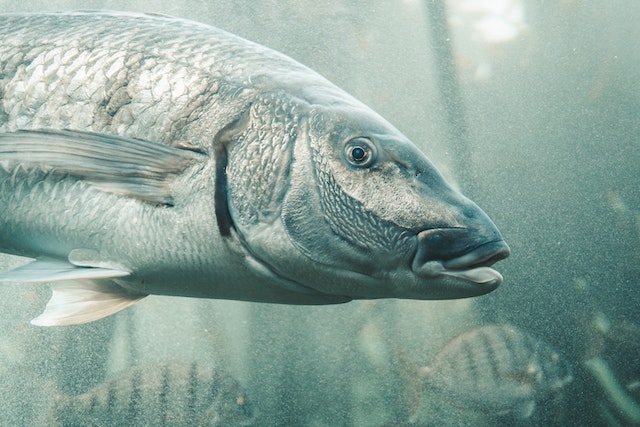
Why do fish have scales? For protection, for camouflage, and to help them swim faster.
There are four basic types of fish scale, but there are many subdivisions within each category. These are the main ones:
Placoid scales. They are found on fish such as sharks and manta rays. They are very similar to teeth, so they are also called denticles. They are small and pointed. The end of the scale is embedded in the fish and the inside of the scale has a pulp with a blood supply. The middle layer is dentine and there is a hard enamel-like outer layer. The scales don’t get bigger as the fish grows. Instead, new scales grow between the gaps formed as the fish gets bigger. The scales feel very rough to the touch.
Cosmoid scales. They are found on lungfishes and many fossilized fish. They are made of bone with an enamel outer surface. As the fish grows, more bone is added at the base of the scales and they grow with the fish.
Ganoid scales. They are found on fish such as sturgeons and bowfin. They are usually a diamond shape and have articulated peg and socket joints between them. They also have a bone base with dentine, but their outer layer is ganoine, not enamel. Ganoine is an inorganic bone salt that looks like glass. This bone salt is the reason they are called ganoid scales.
Cycloid and ctenoid scales. These are the scales that most bony fish have. Cycloid scales have a smooth texture and a uniform size. They have a bony layer on top of a layer of collagen which joins the scale to the fish. Soft-finned fish like salmon have cycloid scales. Ctenoid scales are very similar, except they have small teeth along the edge of each scale. They feel much rougher to the touch, and they are usually found on fish with spiny fins, such as perch. These scales grow with the fish and it is possible to age a fish by looking at its scales because there are growth marks.
So, why do fish have scales? The first reason is for protection. Scales protect the fish in the same way that chain mail protects a knight. The scales are usually made of bone with a hard layer of enamel. The scales help the fish survive an attack by a predator or a collision with a rock or coral. The scales overlap, so a predator’s teeth may slide off the fish if it doesn’t have a perfect grip. The scales also help protect the fish against parasites. Most fish secrete a mucus onto their scales which completely seals them in and keeps all parasites out. If they happen to lose scales in an attack, they will grow them back very quickly.
Fish also use their scales for camouflage. This can be in two ways. The first way is by having different colored scales in different locations to match the surroundings. But most animals are camouflaged this way. Fish are amazing because many of them have reflective scales. Herring, for example, have scales that are angled to reflect the light coming down into the sea. They have a range of spacing between the scales so that they reflect slightly different wavelengths of light, creating a silvering effect that almost makes the fish invisible when viewed from the side. They also have dark scales on their back to be invisible when viewed from the sky. Some scales are used in cosmetics because of this silvering property.
All of these are very important reasons to have scales, but the third reason is probably the most important. The shape of the fish scales causes water to move across them smoothly and reduces drag. If you or I swim underwater, our skin is smooth. The water runs past our bodies and the water right next to our body will swirl and become turbulent, forming vortexes and interfering with itself, causing drag. Counterintuitively, a smooth surface is not best for swimming underwater. The rough shape of fish scales causes the water to channel through the valleys between the peaks of the scales. Because all of the water is being channeled, it doesn’t get turbulent, vortexes are not formed, and there is far less drag. This channeling effect helps the fish to change direction sharply and swim up or down rapidly.
This idea was used to make the LZR swimming suits that were banned after the 2008 Beijing Olympics. The suits had vertical seams sewn into them that mimicked the channeling that fish scales produce. This reduced drag by 24% and 23 world records were broken that year. Critics of the suits called it “technological doping”, but they were just copying fish scales.
So, fish have scales for protection, camouflage, and to help them be more streamlined when they swim.
Sources
https://en.wikipedia.org/wiki/Fish_scale
https://australian.museum/learn/animals/fishes/fish-scales/
https://australian.museum/learn/animals/fishes/cycloid-and-ctenoid-scales/
https://australian.museum/learn/animals/fishes/ganoid-scales/
https://australian.museum/learn/animals/fishes/cosmoid-scales/
https://australian.museum/learn/animals/fishes/placoid-scales/
https://asknature.org/strategy/why-fish-scales-arent-such-a-drag/
